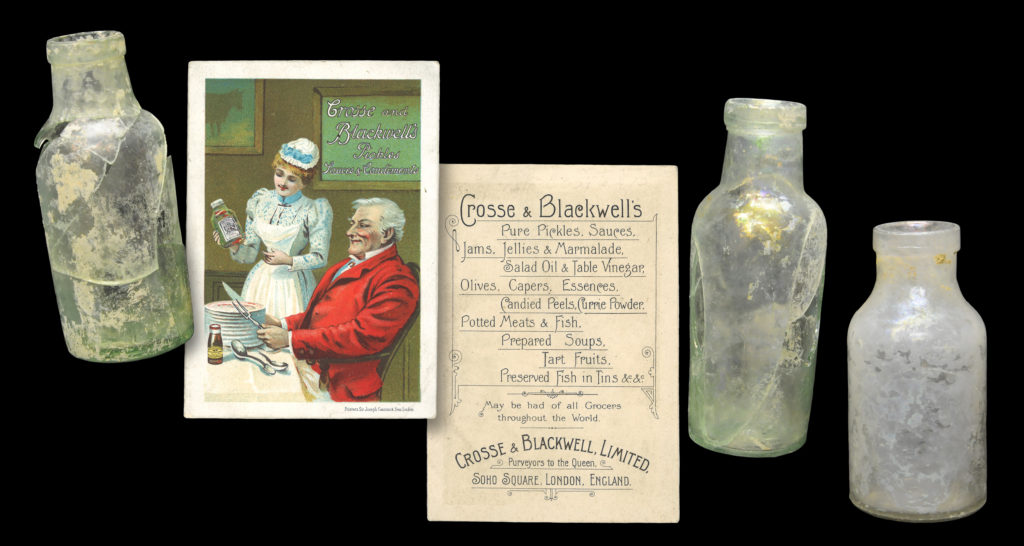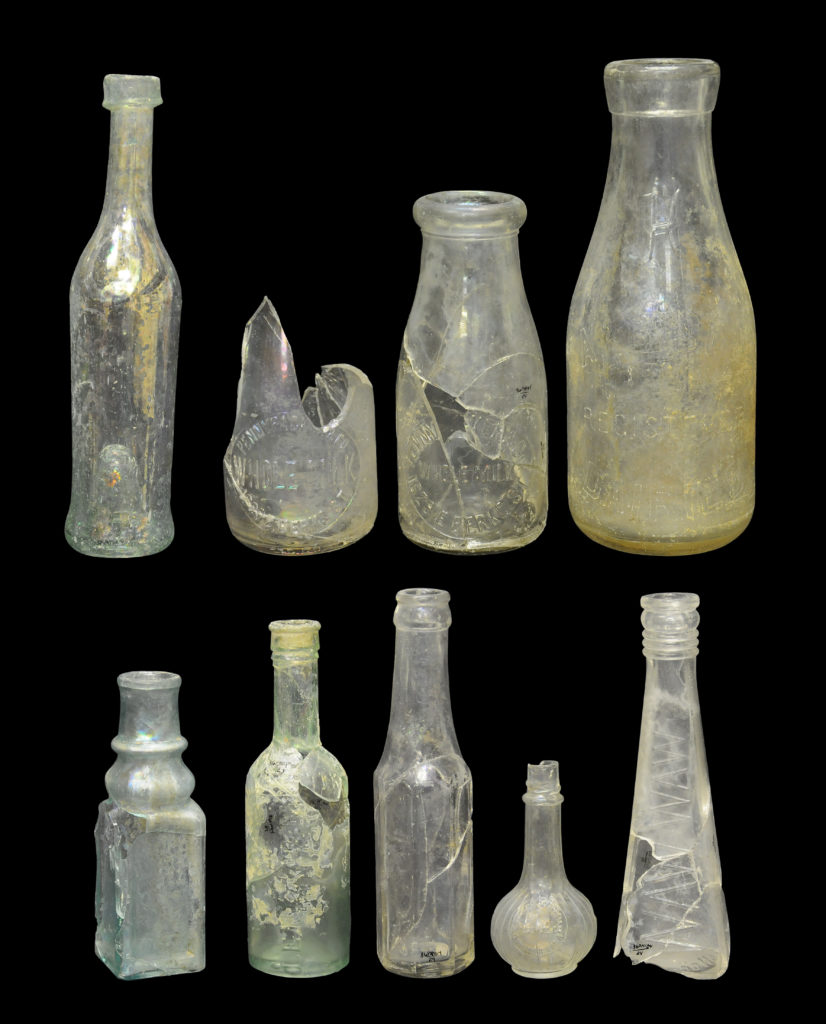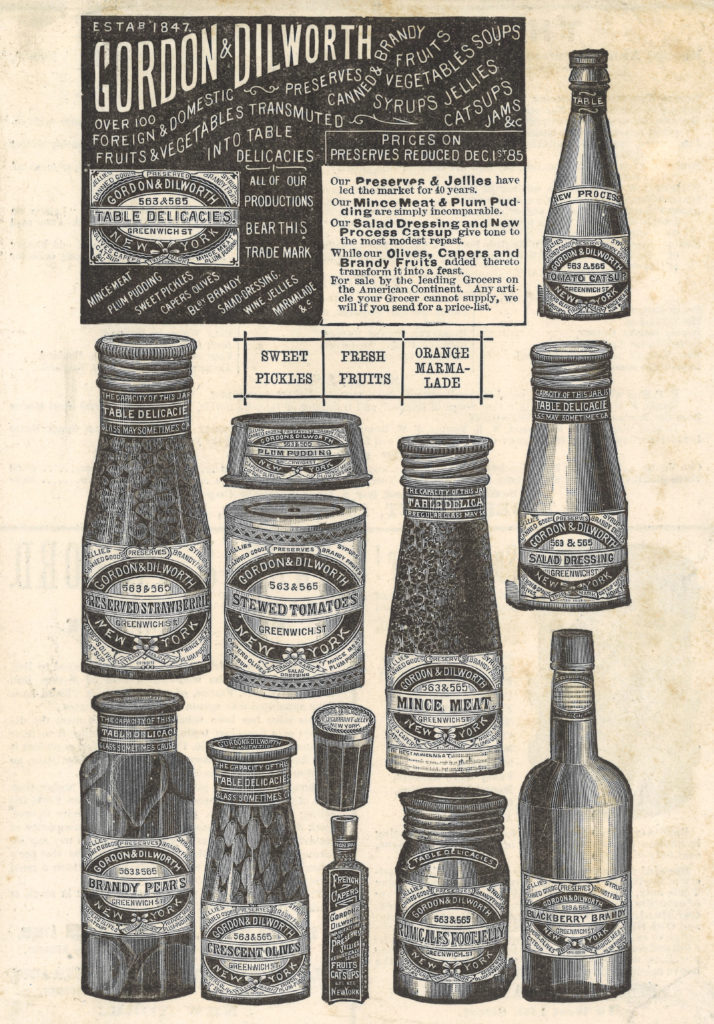Various food bottles and glass storage containers were recovered from this feature along with the beverage bottles and tableware. Some of these glass vessels contained commercially prepared pickled vegetables or sauces.

Food Bottles
A total of 21 food-related bottles were recovered from this privy shaft. The assemblage included seven “ball neck panels,” rectangular bottles with indented panels and molded rings around their necks. The ball neck panel form was frequently used for flavoring extracts between ca. 1865 and the 1950s, but was not exclusive to these products. Indeed, a ca. 1875-1885 “VAN BUSKIRK’S / FRAGRANT / SOZODONT” tooth powder bottle (discussed in another section) exhibits the same form. These seven bottles bear no identifying embossing, and because they lack any evidence of air venting, likely date from ca. 1865-1885.
Two pale green English-made bottles found at this site likely once contained a pickled vegetable mix known as “chow chow” made by Crosse & Blackwell (4A-G-0288 and 4A-G-0358) (Figure 1). The company, which remains in business today, produces a number of food products, including “chow chow,” chutneys, jellies, meat sauces, and relishes, and these bottles may have once held any of the aforementioned items. Both bottles bear the simple “CB” embossing on their bases, and likely date sometime between ca. 1870 and 1915. Another colorless glass bottle features a similar form to the Crosse & Blackwell bottles, a shape usually called “English chow,” “English pickle,” or “chow chow” by bottle makers (4A-G-0034) (Figure 1). 1 This wide-mouth bottle, with its tooled finish and lack of air venting marks, probably dates to the mid-1880s. A single ornate pickle or preserved food bottle was recovered as well (4A-G-0371). This simplified gothic-style bottle, with its blowpipe scarred base and rolled finish, likely dates to the 1850s or 1860s (Figure 2). 2

The small sauce bottle assemblage consists of four vessels (Figure 2). The pale green Lea & Perrins Worcestershire bottle (4A-G-0289) likely dates from the late 1850s to ca. 1877, while the remaining three bottles date to the Bumm family period of occupation. An unmarked, vertically-paneled sauce bottle with a tooled crown finish probably dates from ca. 1892-1910 (4A-G-0125). A small, bellied sauce bottle is marked “JOSEPH CAMPBELL / PRESERVE CO. / CAMDEN N.J. U.S.A.” (4A-G-0011). Based on the name of the company, this small bottle likely dates to the very early 1900s. The Joseph Campbell Preserve Company was an early name used by the Campbell Soup Company between 1892 and 1905. 3 The small mouth, tooled external thread finish on this bottle likely places its date of manufacture shortly after 1900. An unusual tapering rectangular bottled marked “WAW-WAW” was also recovered from this shaft feature (Cat. 24.352). Relatively little is known about these bottles, but they appear to have once contained a pepper sauce and were produced from the 1880s to the 1920s. The recovered bottle features a cup-bottom mold with minimal air venting noted, these characteristics likely date this example from the mid-1880s to ca. 1900.
A minimum of three vegetable oil or salad dressing bottles were present in this shaft feature. One of these, a complete aqua bottle, is free-blown, unmarked, and bears a very crude one-piece applied finish (4A-G-0076). The other two vessels are represented only by bottle seals. One, in olive glass, reads “HUILE D’OLIVE. / I. LATOUR. / SURFINE CLARIFIEE” French for “Olive Oil I. Latour Surfine Clarified.” The other, in aqua glass, reads, “HUILE SURFINE / ESCARRAS a FABRE / MARSEILLE.”

Three milk bottles were recovered from Feature 2, and these would have been delivered by the milk wagons from the nearby neighborhood dairies. Harbison’s Dairy was once located near Norris Square in East Kensington between 1865 and the mid-1960s and received its milk from trains arriving from farms outside the city (Figure 2). 4 The one-quart Harbison’s Dairy bottle shown here dates from sometime after 1913 and, along with another bottle, provides the terminus post quem (TPQ) for Stratum IV (4A-G-0014). The two Pennypacker & Company “WHOLE MILK” bottles are roughly contemporary with the Harbison’s bottle, dating between approximately 1905 and 1925 (4A-G-0136 & Cat. 24.350). The address on the bottles, “1629 E. BERKS ST.”, is located in Fishtown, only several blocks north of the Palmer Burial Ground.
Based on manufacturing dates for these bottles, the assemblage is heavily weighted toward the Cramp family occupation of the property (1849/1850-1889). The remaining 15 vessels all bear manufacturing date ranges within the period of the Cramp family’s occupation of 1018 Palmer Street (1849/50-1889). This assemblage includes seven ball-neck panels, four “chow chow” and pickle bottles, one Worcestershire bottle, three oil/dressing bottles. Only six bottles can be attributed to the Bumm family occupation of the property (1889-1914). These bottles include a sauce/ketchup bottle (ca. 1892-1910), a small Joseph Campbell Preserve Company bottle (ca. 1900-1905), a “WAW-WAW” pepper sauce bottle (mid-1880s – ca. 1900), a Harbison’s Dairy milk bottle (TPQ 1913), and the two Pennypacker & Company milk bottles (ca. 1905-1925).
References
- Bill Lindsey, Pickles & Preserved Foods, Historic Glass Bottle Identification & Information Website. https://sha.org/bottle/food.htm#Pickles & Preserved Foods. Accessed October 2016. ↩
- Bill Lindsey, Pickles & Preserved Foods, Historic Glass Bottle Identification & Information Website. https://sha.org/bottle/food.htm#Pickles & Preserved Foods. Accessed October 2016. ↩
- Andrew F. Smith. Pure Ketchup: A History of America’s National Condiment with Recipes. University of South Carolina Press, Columbia, SC, 1996: 37. ↩
- Oscar Beisert, Melissa Chapman-Smith, Amy Miller, and Bryan Thompsonowak. Harbisons’ Dairies, 2041-2055 Coral Street, Kensington, Philadelphia, Pa. Nomination to the Philadelphia Register of Historic Places, Summer 2016. ↩







